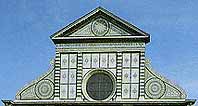
Detail of the facade
Excusez nous mais cette page n'est pas été encore traduite en Français
The decoration, in black and white marble, of the facade of Santa Maria Novella can perhaps be considered to be the most beautiful of all the Florentine churches. The lower part, which dates from the first half of the 14th century, reaches the level of the first cornice: it is similar to the Romanesque facing of the Baptistery but shows Gothic tendencies in the cusp-like forms used for the six sepulchre arches and the two lateral doors. The upper part and the main doorway however are in exquisite Renaissance style, carried out a century afterwards (in 1456) by Leon Battista Alberti; he received the commission to complete the facade, which had been left unfinished from lack of funds, from the rich banker, Giovanni di Paolo Rucellai.

Frontal view of the Basilica
Alberti continued the project, harmoniously integrating the already existing mediaeval elements by developing them along a classical design. He then completed the facade by adding a triangular tympanum, as well as creating the two beautifully inlaid lateral volute or scrolls to hide the slope of the roof that covers the side naves. This device can also be seen in the facade of Santo Spirito and was often used in Baroque architecture. Below the tympanum, the facade of the Basilica is dominated by some large square letters bearing the name of Rucellai, one of the great patrons of the Florentine Renaissance, together with the date, 1470, of its completion. Two astronomic instruments, which were added by the Dominican scholar Egnazio Danti in 1572-74, stand out from the facade: an armillary sphere (on the left) and a marble quadrant (on the right) that mark all the equinoxes and the solstices with complete accuracy.
